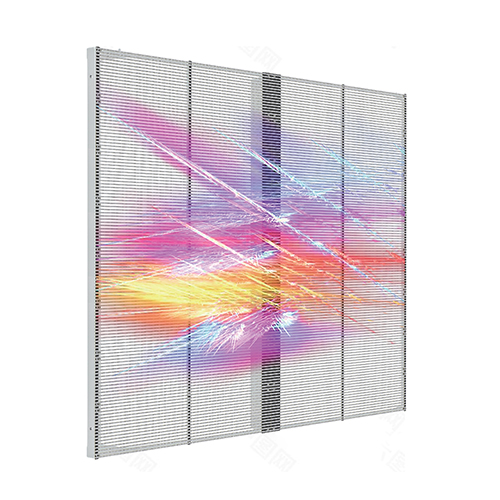NEWS
New Products
Transparent LED screen classification and application analysis
2024-10-21As an innovative display technology, transparent LED screen is widely used in advertising display, building exterior walls, commercial display and other scenes with its high light transmittance, thin and light design and visual impact. With the continuous growth of market demand, the classification of transparent LED screens has gradually become clear, and different levels of screens are suitable for different usage scenarios and needs. This article will discuss the classification of transparent LED screens in detail from the perspective of technical parameters and practical applications.
1. Pixel Pitch
The pixel pitch of transparent LED screens is one of the key factors that determine the display effect, usually expressed in millimeters. The smaller the pixel pitch, the higher the resolution of the screen and the clearer the picture. According to the different pixel pitches, transparent LED screens can be divided into the following categories:
1). Small pitch transparent LED screen
- Pixel pitch: below P2.5
- Features: high resolution, high definition display, suitable for short-distance viewing scenes, such as shopping mall windows, indoor advertising displays.
- Application scenarios: high-end commercial exhibition halls, luxury window displays, museums, conference centers
2). Medium-pitch transparent LED screen
- Pixel pitch: P3-P6
- Features: moderate resolution and display effect, with good light transmittance and display effect balance, suitable for medium-distance viewing.
- Application scenarios: shopping mall atrium, corporate lobby display, brand promotion display, airport advertising screen, etc.
3). Large-pitch transparent LED screen
- Pixel pitch: P6 and above
- Features: relatively low resolution, but suitable for long-distance large-area display, with good light transmittance and large viewing angle.
- Application scenarios: building facade advertising, outdoor glass curtain walls, super-large exhibition displays.
2. Transparency Rate
The transmittance of a transparent LED screen refers to the proportion of light that can be transmitted through the screen, usually expressed as a percentage. The level of transmittance directly affects the application scenario and visual effect of the screen. According to the transmittance, transparent LED screens can be divided into the following categories:
1). High transmittance screen
- Transmittance: more than 70%
- Features: The screen will hardly affect the natural lighting of the rear environment, and is suitable for use in glass curtain walls or places where good lighting effects need to be maintained.
- Application scenarios: architectural glass curtain walls, shopping center exterior walls, office building glass facades.
2). Medium transmittance screen
- Transmittance: 50%-70%
- Features: Suitable for scenes that require both display effects and do not completely block light, and can take into account both display effects and light transmission performance.
- Application scenarios: exhibition halls, brand windows, and perspective display walls in shopping malls.
3). Low transmittance screen
- Transmittance: 30%-50%
- Features: Emphasizes display effects, suitable for use in scenes with low light requirements, but will have a certain impact on the transmission of natural light.
- Application scenarios: indoor advertising screens, stage background screens, interactive displays.
3. Brightness
Brightness is another important factor affecting the viewing effect of transparent LED screens. The brightness level of transparent LED screens is classified according to the intensity of ambient light. Brightness is measured in nits, and the brightness of transparent LED screens is usually divided into the following levels:
1). High brightness screen
- Brightness: above 5000nits
- Features: suitable for outdoor or direct sunlight environments, ensuring clear visibility under strong light conditions.
- Application scenarios: outdoor billboards, building facade displays, square displays.
2). Medium brightness screen
- Brightness: 3000-5000nits
- Features: suitable for semi-outdoor or indoor environments with strong light, balancing display effects and energy consumption.
- Application scenarios: shopping mall atrium, semi-outdoor display, exhibition display wall.
3). Low brightness screen
- Brightness: 1000-3000nits
- Features: Suitable for indoor environment, can provide comfortable visual experience under low brightness conditions, and reduce light pollution.
- Application scenarios: indoor advertising screens, shopping mall window displays, stage display backgrounds.
4. Installation method and structural design
The installation method and structural design of transparent LED screens are also different according to different application scenarios. The installation flexibility of the screen determines whether it can adapt to a variety of complex installation environments.
1). Fixed installation screen
- Features: Mainly used for long-term display, the screen and the installation frame are integrated with the design, and the stability is high.
- Application scenarios: building exterior walls, exhibition centers, shopping mall advertising displays.
2). Modular installation screen
- Features: Through modular design, splicing and customized installation are realized, which is suitable for display requirements of special sizes and complex structures.
- Application scenarios: exhibition venues, stage backgrounds, brand flagship stores.
3). Movable screen
- Features: Lightweight structure design, easy to disassemble and move, suitable for temporary display and flexible display needs.
- Application scenarios: mobile booths, temporary exhibitions, activity background walls.
Through the above analysis, the classification of transparent LED screens is based on multiple dimensions such as pixel pitch, transmittance, brightness and installation methods. When choosing, companies should comprehensively evaluate various technical parameters based on specific application scenarios and needs. Different levels of transparent LED screens have different characteristics and advantages. Whether they are used for high-end commercial displays or large-scale outdoor advertising, they can bring excellent visual effects and user experience to companies. By reasonably selecting the right level of transparent LED screens, companies can not only enhance their brand image, but also achieve more efficient marketing and information transmission.






